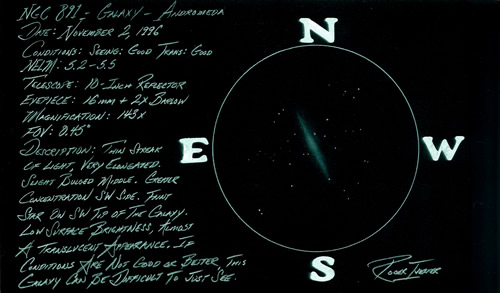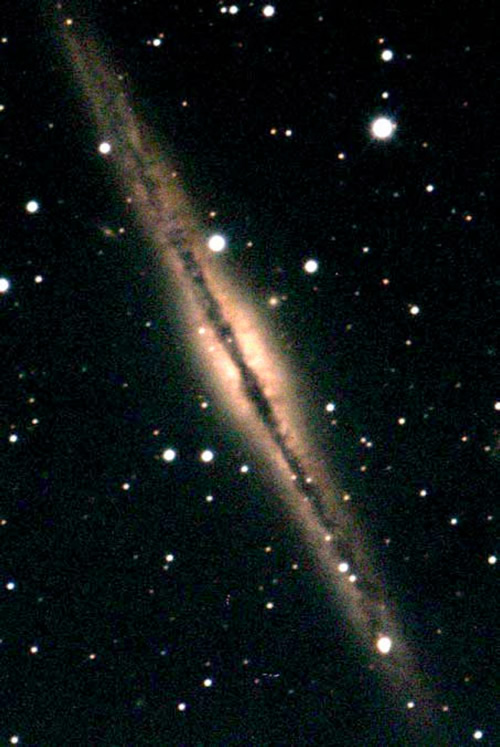
Located about halfway between Gamma Andromedae and bright open cluster M34, lies our object of study this month; the highly elongated galaxy known as NGC 891. This is a very difficult object for anything less than a 6-inch telescope, but I've glimpsed it from my moderately light-polluted backyard in North Carolina, using a 102mm (4-inch) refractor.
When using my 10-inch f/4.5 reflector at a magnification of 57x, this galaxy appears as a very faint thin streak of light. When increasing to 143x, details begin to emerge. However, conditions must be very good to use a magnification this high, due to the very low surface brightness. The following sketch was made using a No. 2 pencil and a blank 5 X 8 notecard with the colors inverted using a scanner.

The galaxy's texture seems to take on a translucent effect, almost as if you're looking right through it. The slightly bulged and brighter central region is very obvious and easy to see. When using averted vision, it has a very faint and dim core. The galaxy is oriented NNE-SSW, and a magnitude 13 star can be seen on the very tip of the more extended, brighter SSW arm. A magnitude 12 star lies NNW of the brighter central region, almost touching the halo. This galaxy is indeed faint, but the edges appear well defined and very sharp, when using averted vision. A dark lane runs the entire length, but I've never been able to see this feature from my backyard using the 10-inch. Can you see the dark lane?
Fred Rayworth, using a 16-inch reflector from the desert SW in Nevada said: "I could plainly see the dark lane at a magnification of 109X, using averted vision. When increasing the magnification to 229X, the dark lane jumped out, using direct vision."
Rob Lambert, also observing from Nevada, and with the same 16-inch telescope said: "The galaxy appeared as an elongated smudge, with a perceived darkening along its' mid-line."
The following image was made by Dr. James Dire of Hawaii using the 20-inch Parallax RC Cassegrain telescope at the U.S. Coast Guard Academy Astronomical Observatory in Stonington, Connecticut. James said: "Amazing I picked up so much of the galaxy in a 10 minute exposure!!!!"

Sue French from New York, using a 10-inch Newtonian reflector at 115X said: "NGC 891 is gorgeous! The galaxy is greatly elongated north-northeast to south-southwest and appears very mottled. A star is pinned to the galaxies' western flank, north of the brighter core. Another star marks its southern tip. I can see just a hint of the dark lane that runs the length of NGC 891. At 166X, the dark lane is more readily visible, sketched through the galaxy midline. The lane is most apparent across the core, which is a flattened oval that slightly bulges out from the galaxies slender profile."
Jaakko Saloranta from Finland said: "You know, I was once able to see this galaxy using a 3-inch refractor under suburban skies! Of course, under dark skies it is not "too" difficult to see with a pair of 8x30 binoculars, although seeing it requires a tripod and a careful gaze...says my logbook. ack in 2009 I observed the galaxy with a 4.7-inch refractor. I wrote to my sketch: 8' x 1' discus -shaped, somewhat low surface brightness with several stars peppered within and around it. The galaxy is elongated in a NE-SW direction. When viewed at 204x the dust lane is fairly prominent, especially in the central bulge."
Roger Ivester has enjoyed the wonders of the night sky since he was 12 years old. He is a visual observer and enjoys sketching and writing about what he sees. In 2009 he helped start the Las Vegas Astronomical Society Observers Challenge, and works with fellow club member Fred Rayworth of Nevada on a monthly basis to compile the report. Roger and his wife Debbie live in the foothills of western North Carolina, with their Persian Cat CJ, and their miniature long haired Dachshund, Nova Sophia.




















